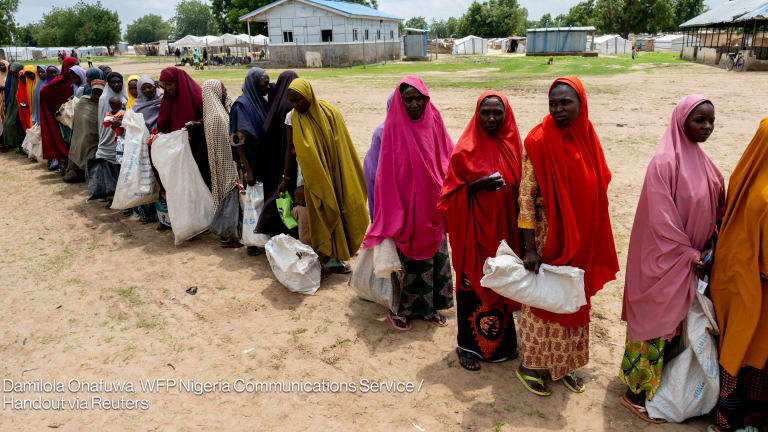
The COVID-19 pandemic has again shown us how interconnected and vulnerable our societies are to shocks and stresses. Now more than ever, humanitarian and development actors need to think of resilience building in a more systemic way and make sure that no one is left behind.
To do this, we suggest developing a different approach to resilience building.
Human societies function based on our ability as a species to collaborate — sometimes on a massive scale — to deliver goods, services, and other benefits. However, this collaboration is often not well structured or efficient, and it can be vulnerable to disturbances or result in exploitation, marginalization, and exclusion.
To achieve this scale of collaboration, societies are made up of a whole range of socioeconomic systems, such as market systems or public health systems. Within each of these systems, there are networks of actors — people and organizations — interconnected and working together, intentionally or not, to achieve a shared outcome.
Often, there is no mechanism for overseeing or managing these systems of collaboration. And as a result, inequalities, vulnerabilities, and inefficiencies can be overlooked. These systems are sometimes not working well — or not at all — or they can be vulnerable to shocks and stresses that affect how they function, cutting off the supply of critical goods and services in normal times or in times of crisis, when they may be needed most.
We believe that the ability of vulnerable populations to be resilient to risks is related to how well critical socioeconomic systems are functioning in normal times, as well as during and after times of crisis. The more resilient and inclusive these systems are, the more capacity communities have to achieve their development goals and the more resilient they will be when facing adversity.
What can be done differently to build resilience?
We suggest adopting a systems approach to build resilient and inclusive socioeconomic systems. To guide this, we at GOAL have developed the Resilience for Social Systems, or R4S, approach, which is a step-by-step guide structured into five key components, to identify, map, and synthesize socioeconomic systems against risk scenarios.
• Component 1: Socioeconomic systems are prioritized based on their relevance to the target group, opportunity to achieve change at scale, feasibility within resources of intervention, and contribution to the target group’s resilience.
• Component 2: The current status of the socioeconomic systems is mapped to understand the role of the various actors in the systems and their relationships with each other.
• Component 3: Risk scenarios are identified to prioritize those that could potentially affect the selected socioeconomic systems, considering the probability of occurrence and level of impact.
• Component 4: The resilience of the system is analyzed through a vulnerability assessment and causal loop analysis. Then, the system is assessed against six determinant factors of resilience: connectivity, diversity, redundancy, governance, participation, and learning. A systemic theory of change can now be developed, as well as a map setting out the future vision of a socioeconomic system with proposed changes to increase resilience and inclusion.
• Component 5: A participatory monitoring, evaluation, accountability, and learning process takes place. From the selection of the initial planning to the selection of the target systems, the analysis and monitoring of change throughout the entire process should be undertaken with the system stakeholders.
GOAL’s systems approach to resilience building is based on the best practices identified in systems thinking, network theory, scenario thinking, social and behavior change, and inclusion and resilience approaches.
The overall framework for the R4S approach is the Resilience Lens, which is focused on the target population in the center, with the ring at the next level depicting the range of socioeconomic systems that are relevant to community resilience. The outer rings of the lens represent the broader encompassing “social, cultural, and governance” context and the “physical and environmental” context.
Shocks and stresses can originate from these two contexts, either coming from only one or a combination of the two. These shocks and stresses combine to form risk events that can result in crises that reverse hard-earned development gains and disproportionally affect the poorest and most marginalized.

GOAL’s Resilience Lens recognizes that for societies to be resilient and inclusive, they must exist in the niche space, which is bound by the upper limit of the ecological ceiling — defined by sustainable extraction from the environment — and also by the social foundation — defined by ensuring a minimum level of access to basic services and social welfare.
A systems approach provides opportunities to stimulate lasting solutions that increase self-reliance and the ability to reach large numbers of people. It contributes to building the capacities of permanent local actors within systems — the state, private sector business, civil society, or communities — to absorb, adapt, and transform when facing shocks and stresses and minimizes unintended consequences on local socioeconomic systems or on the roles played by permanent actors.
We recognize that systems change and behavior change are two sides of the same coin and that systems change cannot be achieved without the behavior change of the system stakeholders. But equally, behavior change must be based on an understanding of wider system function.
Examples of this approach in play
Q&A: Why resilience is key to improved delivery of aid
How can a humanitarian agency help build resilience while addressing emergency needs in a crisis? GOAL's Bernard McCaul explains.
The R4S approach has been applied across a range of socioeconomic systems in different contexts in Latin America and Africa. For example, we applied this approach in our urban resilience program Barrio Resiliente, which targets the building of resilience in informal urban settlements and has shown very positive impact both in terms of strengthening collaboration between stakeholders and achieving measurable results in reducing disaster risk.
It has also been applied to the small-scale fishery market systems through our Resilience of the Blue Economy program, which targets marginalized Indigenous and Afro-descendant populations in remote coastal regions. We are also applying this approach to health resilience in fragile and conflict-affected contexts.
Applying the R4S approach to these interventions has helped GOAL teams to change their perspective and enabled them to look at the bigger picture and better understand the root causes of vulnerability and poverty. It has also guided engagement with a range of local actors based on a better understanding of their role in the socioeconomic systems in which they live and work.
For more information, please see the R4S guide.
Visit the Resilient Futures series for more coverage on the practical ways cities can build resilience and reduce disaster impact. You can join the conversation using the hashtag #ResilientCities.











